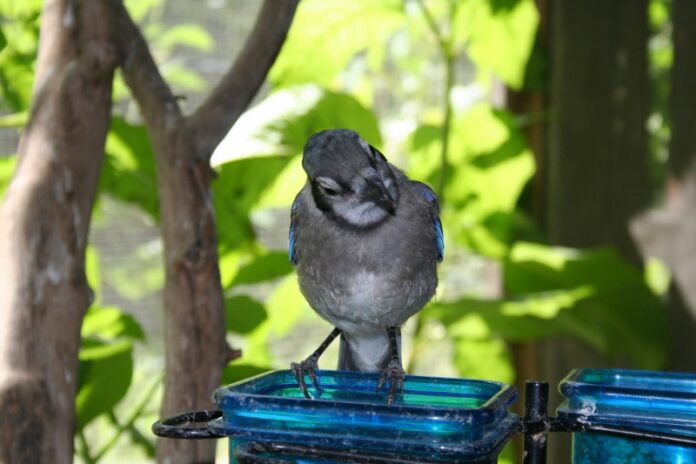 For those us who care deeply about birds, here are some ideas we can use in our own backyards to make their Spring easier. It’s not too soon to start in the Roanoke Valley; bluebirds are already scouting out nesting sites; they will lay their eggs in April. Most experts say: Have your bird houses up and clean by March 1st.
For those us who care deeply about birds, here are some ideas we can use in our own backyards to make their Spring easier. It’s not too soon to start in the Roanoke Valley; bluebirds are already scouting out nesting sites; they will lay their eggs in April. Most experts say: Have your bird houses up and clean by March 1st.
As regards bird housing, don’t automatically cut down an old tree, as they often have cavities which provide many of our local birds with homes. These trees also offer shelter and foods: insects, sap, etc. Think of it this way: A tree is a habitat unto itself!
Diet: The following foods will accommodate most Virginia species: black-oil seeds, sunflower hearts, hulled and un-hulled unsalted peanuts, meal worms, wild bird seed, nut mixtures, Niger and millet seed. Suet mixtures are commercially available, and there are on-line recipes for home-made suet. Consider planting regional winter-bearing bushes and plants. http://www.nativeplantcenter.net
Vary your types of feeders. Some birds cling to eat, perch, or ground-feed. Depending on the species of bird you expect to visit, bin [or hopper] feeders, platform feeders are popular. It’s a good idea to vary the feeders’ location to prevent a build-up of droppings on the ground beneath which would endanger ground feeders. Alternately, rake the ground clean, and consider spreading clean gravel or mulch. [Note: When there’s snow on the ground, use pie pans; remove at night; keep clean.]
Clean feeders attract more birds! When we speak of cleaning, we mean: perches, corners, edges, reservoirs, feed ports… every part of a box or feeder. It is good to have replacement feeders.
Bird’s primary threats are from molds, fungi, mildew, and bacteria which often cause highly contagious pink-eye (conjunctivitis.) Always wear disposable gloves when cleaning [humans can contract and spread conjunctivitis.] The molds and bacteria can sicken, or kill, adult birds, and, more often, their babies.
Good cleaning solutions include one part bleach to ten parts water, or, any all-purpose natural cleaner available locally. Giving the houses a good brushing is preferable to any chemicals, just be sure to get in the nooks and crannies. Scrape off any debris that resists brushing. Don’t purchase birdhouses that cannot be opened for cleaning.
Tubular feeders have perches, and we recommend against them. Some species of perch-feeding birds clean their bills on the feeder’s perch. If the bird has conjunctivitis germs, it will remain on the perch and spread to the next bird.
As regards bird-houses: remember the construction of bird houses and feeders is a great project for our youngsters! They can learn about the environment, wildlife, building, and the safe use of tools. Species-specific building diagrams and specifications can be found in the following books: Landscaping for Wildlife, and Woodworking for Wildlife, both authored by Carrol Henderson. We prefer the Peterson design for bluebirds. But, again, be sure your design allows for inside brushing-out.
Caution: a new fad on the market is the use of re-cycled plastic to build bird homes. Sabrina simultaneously measured temperatures inside and outside the structures, and found they’re more like stoves than homes.
We suggest non-toxic paints, cedar wood, or salt-treated lumber. Feeders will probably be used by birds in the same season they are constructed, but it may take six months to a year for a bird house to be used.
Face nest-box openings away from the prevailing winds, and if possible, so that they will receive afternoon sunshine. Set boxes near natural windbreaks, including your house; but no closer than five feet to reduce the risk of window collision. However, if your home is outdoor ‘busy’ or noisy with pets or young children, this would not be a good location. Some birds prefer housing at the edges of forested areas; others prefer open areas. Depending on the species you want to attract, checking into their preferences will increase your chances of success.
If your bird houses are on poles, baffles are, quite literally, bird life-savers. A good baffle is a simple stovepipe around the house stand to block out snakes and climbing predators. As has been said, “Without baffles, we’re not serving birds, we’re serving lunch.”
Final notes:
Please keep cats inside. It’s safer for our birds, and safer for our cats
Consider heated bird-baths in winter. [Don’t forget to clean them; using water only.]
Inspect birdhouses for limbs – and especially vines – that are touching. Ants use these as bridges to enter the houses and destroy eggs, and the parents can do nothing to prevent this attack.
As the warm weather comes, please use only “no melt” suet. It has been found that regular suet can stick to the feathers around a bird’s mouth or eyes. Then, when the bird preens, the melted suet adheres to the feathers. Oil-based products are very damaging to feathers and follicles, When follicles are destroyed, the feathers never grow back. This can lead to the bird’s inability to regulate its heat, and, in some cases, the death of the bird. So, in warm months, I would be very concerned about home-made suet, or commercial suets not labelled, ‘No Melt.”
Southwest Virginia Wildlife: www.facebook.com/SWVAWILDLIFE


